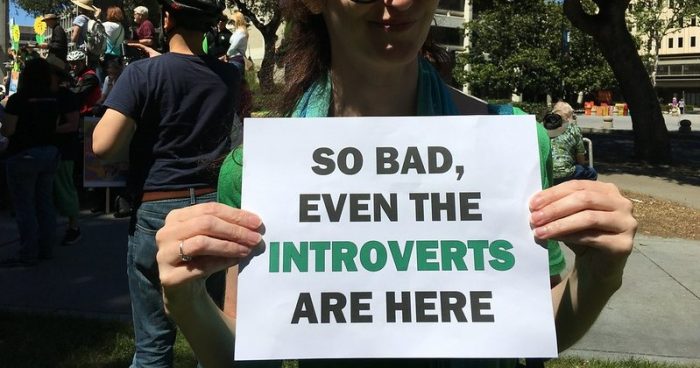A global study, recently published, has found that young people are suffering “‘profound psychological distress’ due to climate change and government inaction on the climate crisis.”
In her article on CNBC, Vicky McKeever stated that: “The study, which was said to be the first large-scale research of its kind, was led by academics from the United Kingdom’s University of Bath and the Stanford Center for Innovation in Global Health, among others. It is under peer review in The Lancet Planetary Health journal.”
10,000 young people were surveyed across 10 countries for the study. Around 45 percent said anxiety and distress over the climate crisis was affecting their daily life and ability to function.
Young people in this study ranged from aged 16-25. Three-quarters of these young respondents felt that the “future is frightening” and 64 percent said that governments were not making an effort enough to steer clear of a climate crisis.
Nearly two-thirds of young people felt betrayed by governments, and 61 percent said governments were not protecting them, the planet, or future generations.
“Climate change has significant implications for the health and futures of children and young people, yet they have little power to limit its harm, making them vulnerable to increased climate anxiety,” according to the researchers.
I listened to an interview by one of the authors of the study who warned that such high levels of distress, functional impact, and feelings of betrayal will inevitably influence the mental health of children and young people.
She added that even though anxiety over climate change may not lead to mental illness, “the realities of climate change alongside governmental failures to act are chronic, long term, and potentially inescapable stressors; conditions in which mental health problems will worsen.”
When asked for specific ways this anxiety was affecting their lives, young people stated they were unable to concentrate, were doing poorly in their studies, didn’t feel like engaging in play, and were not motivated to plan for a future. Four in 10 young people around the world are hesitant to have children as a result of the climate crisis.
“Kids are very media savvy. They’re not living in a cave,” Lisa Van Susteren, a general and forensic psychiatrist and co-author of the study said. “They have heard about what the future looks like. They’ve heard the warnings.” She added that the findings of the study are also as much a measure of climate denial among adults as they are a measure of kids’ anxiety.”
Caroline Hickman, from the University of Bath, Climate Psychology Alliance and co-lead author on the study, said, “This study paints a horrific picture of widespread climate anxiety in our children and young people. It suggests for the first time that high levels of psychological distress in youth is linked to government inaction. Our children’s anxiety is a completely rational reaction given the inadequate responses to climate change they are seeing from governments. What more do governments need to hear to take action?”
I decided to drill down a little further and remind myself why all these fears are legitimate. I culled this information on climate change from NASA’s website:
Direct observations made on and above Earth’s surface show the planet’s climate is significantly changing. Human activities are the primary driver of those changes.
The effects of human-caused global warming are happening now, are irreversible on the timescale of people alive today, and will worsen in the decades to come.
In short, global temperatures will continue to rise.
Oceans will become warmer.
Snow cover will decrease.
Changes in rain patterns will lead to more flooding.
There will continue to be more intense droughts and heatwaves.
There will be more wildfires.
Effects on the ecosystem and agriculture will create food shortages.
Hurricanes will become stronger and more intense.
Sea levels will rise 1 to 8 feet by 2100.
There will be continued glacial retreat, and the arctic is likely to become ice-free.
Looking at just the United States, this is how NASA says these changes will affect specific regions of the country:
>> Northeast
Heat waves, heavy downpours, and sea-level rise pose growing challenges to many aspects of life in the Northeast. Infrastructure, agriculture, fisheries, and ecosystems will be increasingly compromised. Many states and cities are beginning to incorporate climate change into their planning.
>> Northwest
Changes in the timing of streamflow reduce water supplies for competing demands. Sea level rise, erosion, inundation, risks to infrastructure, and increasing ocean acidity pose major threats. Increasing wildfire, insect outbreaks, and tree diseases are causing widespread tree die-off.
>> Southeast
Sea level rise poses widespread and continuing threats to the region’s economy and environment. Extreme heat will affect health, energy, agriculture, and more. Decreased water availability will have economic and environmental impacts.
>> Midwest
Extreme heat, heavy downpours, and flooding will affect infrastructure, health, agriculture, forestry, transportation, air, and water quality, and more. Climate change will also exacerbate a range of risks to the Great Lakes.
>> Southwest
Increased heat, drought, and insect outbreaks, all linked to climate change, have increased wildfires. Declining water supplies, reduced agricultural yields, health impacts in cities due to heat, and flooding and erosion in coastal areas are additional concerns.
The evidence is in—our kids are feeling frightened and impotent about what their future holds.
Can we please take note?
We can each study up and do all we can to reduce our own carbon footprint, but the real solutions need to come from governments across the globe, taking immediate giant steps.
Governments must legislate changes in sustainability and renewables, in eliminating plastics, in encouraging plant-based eating, in investing in land and water conservation, in increasing their own emission reduction targets.
So what is the most important thing we can do? We must vote—vote for legislators who are committed to impacting the climate crisis. What is even better is to identify them, campaign for them, contribute to their electability, and help to educate voters.
We all need to do everything we can.
Please, let’s do it for the kids.












Read 30 comments and reply